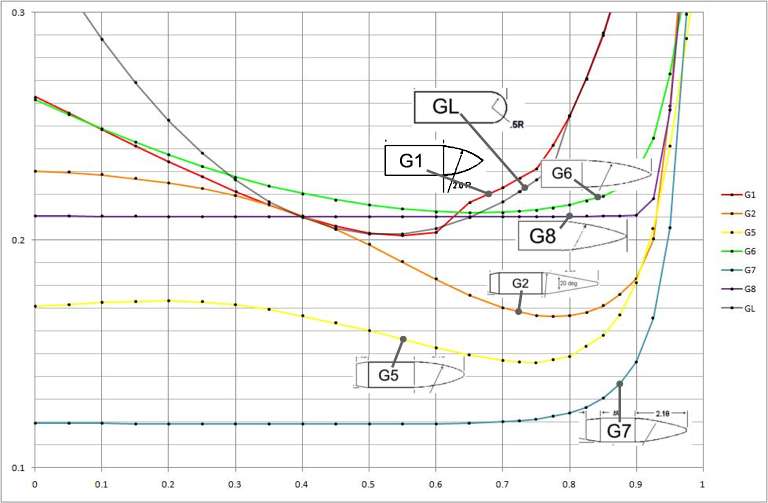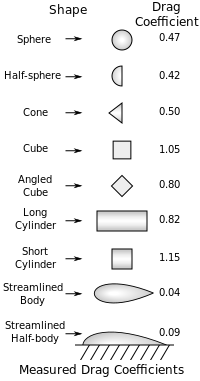Page 3 of 10
Posted: Tue Oct 11, 2011 2:25 pm
by Labtecpower
I drew it small scale because it's roughly the dimesions I intent to build it to, for testing from a 6mm pneumatic

How the hell will you find it
 I believe I heared someone say that you like to work in scales familiar to you...
I believe I heared someone say that you like to work in scales familiar to you... 
Posted: Tue Oct 11, 2011 2:47 pm
by danielrowell
Just to throw this out there.
Why not use a round-nosed projectile? They generally have the best ballistic coefficients at sub-sonic velocities. If you made the nose out of a tough material it should be able to withstand multiple shots.
Posted: Tue Oct 11, 2011 2:50 pm
by saefroch
Has anyone considered modifying an invisible fence for projectile retrieval? I assume you could attach the tag to the projectile or place it inside, but set it to trigger some sort of action other than an electrical shock, then sweep down the beach with the fence. That or you could do it in reverse and sweep with tags, though that may not work so well

.
EDIT: Round-nose projectiles do better supersonic. I'm sure JSR or RAG can dig up the simulation that RAG ran for the standard projectile shapes. The end result is that a G7(tangent ogive) shape with a back that's a conic section, but not a full cone, has the lowest drag coefficient subsonic. G6 projectiles have a round nose, and do better ONLY supersonic. They lag significantly subsonic.
Posted: Tue Oct 11, 2011 3:09 pm
by jackssmirkingrevenge
Labtecpower wrote:How the hell will you find it

This is not for long range shooting, as I made it clear I have neither the space nor the opportunity to shoot in public available. I just want to see if an unfinned elongated projectile can be stabilised by forward CG alone.
I believe I heared someone say that you like to work in scales familiar to you... 
I believe my retort was along the lines of my clearly not having to compensate for anything

I'm sure JSR or RAG can dig up the simulation that RAG ran for the standard projectile shapes.
Here be the
epic projectile shape thread.
Submarines are teardrop shaped. Bullets made for subsonic sniper rifles are pointy. I find that pretty convincing.
LOL at the idea of a hybrid-launched fence

Posted: Tue Oct 11, 2011 3:12 pm
by dewey-1
JSR
The CP is 31.47mm from tip.
As long as the CG is 25 mm or less it will be stable.
Seeing as the nose is about 6 times heavier than the body, the CG will be quite a ways ahead of the CP point.
Posted: Tue Oct 11, 2011 3:23 pm
by jackssmirkingrevenge

Cheers, was hoping you'd see this

Posted: Tue Oct 11, 2011 4:01 pm
by velocity3x
dewey-1 wrote:As long as the CG is 25 mm or less it will be stable.
CG = -23.622mm.
Mass= 4.535 grams +/-
Posted: Tue Oct 11, 2011 4:35 pm
by danielrowell

Seven pages-worth of heated debate is enough to convince me that this is a touchy subject. I just know that most subsonic model rockets use an airfoil shape for their fins to minimize air resistance. But I digress. I don't want to start an argument on a subject that's already been discussed by minds that are more learned than mine.
Saefroch wrote:Round-nose projectiles do better supersonic.
I do know a bit about this, though. Round surfaces create a detached shockwave in supersonic flight that greatly increases air resistance, don't they?
Posted: Tue Oct 11, 2011 4:44 pm
by al-xg
Lol how are we getting different results ?

Is this with:
Brass cone 15mm long, OD 6mm
Brass cylinder 5mm x 5mm OD
POM 25mm long by 6mm dia, with 5mm dia hole x 5mm deep
POM 30mm taper, OD 6mm
Brass 8.6g/cm3
POM 1.4g/cm3
?

typical

Dewey how do you estimate the CP, are you using a function of your CAD package or some other means of working it out ?
Posted: Tue Oct 11, 2011 4:44 pm
by saefroch
danielrowell wrote:I do know a bit about this, though. Round surfaces create a detached shockwave in supersonic flight that greatly increases air resistance, don't they?
I think so. But if you want to make a high-school physics teacher look unintelligent, ask them why a G6 is better than a G7 supersonic, but not subsonic. Few know.
Posted: Tue Oct 11, 2011 5:49 pm
by dewey-1
Here are the results I got.
For CP, I just use the centroid of the whole projectile.
Basically the center of mass. (assuming the same material)
The CG is not calculated but a one caliber static margin is the minimum for stability.
I have not quite figured out how to get CG with two different materials yet or at least not with my CAD program.
JSR can give us the exact CG and weights when he finishes machining.
It would be interesting to compare the actual results to a 3D model.
Posted: Tue Oct 11, 2011 6:13 pm
by al-xg
Ok, in that case I get a CG 1.68 calibers ahead of the centroid.
And same total weight.
It would be interesting to compare the actual results to a 3D model.
Indeed, especially as even the theoretical models so far seem to give very slightly different values

Mmm it would be interesting to get a measured value of the CP so we can work out a smuge factor for cylinder/cone shaped solids.
Posted: Tue Oct 11, 2011 8:02 pm
by Ragnarok
saefroch wrote:I'm sure JSR or RAG can dig up the simulation that RAG ran for the standard projectile shapes.
It wasn't a simulation, it was just a collation and visualisation of the data from various real world tests. Still, it's surprisingly hard to find the numbers for some of those tests.
But anyway, here's the most pertinent picture:
 Relevant shapes here.
Relevant shapes here.
GS, GL, G1 (and the similar GI) are the roundest nosed (to the point that GS is actually a sphere), but also quite clearly the worst supersonic.
Not great subsonic either. G1 and GL dip near 0.2 Cd at a little over half Mach, but G7 is a cool 0.12 all the way up to about 80% Mach.
But if you want to make a high-school physics teacher look unintelligent, ask them why a G6 is better than a G7 supersonic, but not subsonic.
Well, G6 only starts beating G7 past about Mach 3, and there's only really a hair's breadth in it.
Boat-tails get less useful as the wake of the bullet extends, so Mach 3 is going to be about when the G6's longer nose starts providing a bigger bonus than the G7's boat-tail.
Posted: Tue Oct 11, 2011 11:27 pm
by jackssmirkingrevenge
Cheers all for the contributions and modelling.
I was thinking about this during my fase REM, that small diameter Delrin taper at the end is going to be <s>a bitçh</s> an interesting challenge to machine...
Posted: Wed Oct 12, 2011 12:37 am
by danielrowell

With G8 sharing the nose radius of G7, just without the boat-tail, it would be interesting to see what would happen if GL was tested with a boat tail. It's possible that it would have less air resistance than G7 at around mach .55. Even so, I'd have to agree that G7 can't be beat when it comes to having a flat Cd at sub-sonic velocities. In the long run, it would almost certainly go farther than GL even if GL had a boat-tail.
I wonder what the results would be if a streamlined body of about the same size was tested like the one in this picture?




